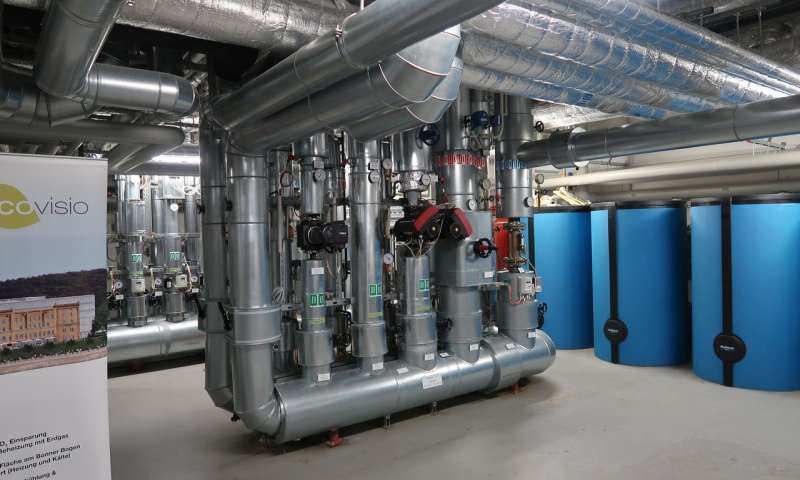Geoscientists Study Possibilities of Heat and Cold Storage in Aquifers
Published on by Water Network Research, Official research team of The Water Network in Case Studies
In a new project, scientists are evaluating the efficiency of one of the largest aquifer-based geothermal facilities in Europe and the only one of this kind in Germany.
In this year’s record summer, everybody wishes to have a cooled home or office. But air conditioning systems consume a lot of energy and are far from being environmentally compatible. Researchers of the GeoSpeicher.bw project coordinated by Karlsruhe Institute of Technology (KIT) are studying alternatives with a reduced energy consumption. These include storage and later retrieval of heat and cold in underground water-bearing layers, so-called aquifers.

The aquifer storage system in Bonn supplies up to 80% of the heat and cold in three buildings covering a total area of 60,000 m². Credit: Paul Fleuchaus, KIT
In a new project, they evaluate the efficiency of one of the largest aquifer-based geothermal facilities in Europe and the only one of this kind in Germany. Since 2009, an underground aquifer storage system has supplied the Kameha Grand hotel and two office complexes in a newly developed district of Bonn with cold in the summer and heat in the winter. “The system supplies up to 80% of the heat and cold of the buildings of about 60,000 m² in area,” says Steffen Große from EcoVisio GmbH, the responsible utility company. As compared to conventional energy supply, energy consumption of this geothermal facility is lower by about 1700 MWh every year. CO2 emissions are reduced by 400 tons annually.
“We are very lucky to have this facility in Bonn,” says Professor Philipp Blum of KIT’s Institute of Applied Geosciences (AGW). “We have access to data covering a period of nearly ten years and, hence, can study various aspects ranging from energy efficiency to building technology.” Steffen Große and his colleagues hope that scientific data analysis will result in an optimization of the system. “Due to the changing climate, we partly have to start cooling the buildings in March already,” he reports. “Within the GeoSpeicher.bw project, we cooperate with geologists and experts for energy and building technologies to derive the best possible operation mode under the changed boundary conditions in the future.”
Conventional geothermal heat pumps are becoming increasingly popular in Germany. About 350,000 systems are installed in new buildings in particular. “These geothermal heat pumps are mainly used for heating in winter,” says Philipp Blum. “Aquifer storage systems, by contrast, can do both: cooling in summer and heating in winter,” he points out. Paul Fleuchaus, doctoral researcher of AGW, adds: “When constructing new buildings in Germany, hardly anybody considers energy supply by aquifer storage systems. This is different in the Netherlands,” he says. “There, more than 2800 systems are operated successfully.” Due to their large capacity, aquifer storage systems are suited in particular for large buildings, such as museums, hospitals, office buildings, or hotels. Also in residential areas, aquifer storage systems combined with local heat networks can be used. In the Netherlands, the technology is also applied for industrial complexes, such as greenhouses or computing centers. According to calculations of the scientists, a return on investment is often reached after two to ten years already.
The scientists of the project GeoSpeicher.bw say that thanks to the geological conditions, a number of regions in Germany and Europe, but also worldwide are suited for aquifer-based geothermal energy supply. The experts of Karlsruhe Institute of Technology, the universities of Heidelberg and Stuttgart, and the universities of applied sciences in Biberach and Offenburg also study heat and cold storage with the help of tunnel systems, such as the Rosensteintunnel in Stuttgart.
“We expect energy consumption for air conditioning systems to increase by a factor of 33 by 2100,” says Paul Fleuchaus. “The recent collapse of the power grid in parts of California shows that this can be managed with neither the existing grid nor conventional energy carriers,” he says. To identify alternatives, technical analyses are accompanied in the project GeoSpeicher.bw by studies relating to public acceptance and current legislation. ”In the Netherlands, we found that close cooperation of authorities, scientists, the public, and utility companies is very effective,” Fleuchaus says.
More information:
https://www.kit.edu/kit/pi_2017_005_geothermie-den-sommer-im-winter-ernten.php (in German only)
http://exhibition.klimaexpo.nrw/projects-pioneers/hotelkameha.html ![]()
https://www.energieagentur.nrw/geothermie/geothermie/energiekonzept-fuer-das-kameha-grand-hotel-in-bonn ![]() (in German only)
(in German only)
Current Publication
Fleuchaus et al.: Worldwide application of aquifer thermal energy storage – A review“, Renewable and Sustainable Energy Reviews, volume 94, October 2018, Pages 861-876. Abstract online unter: https://www.sciencedirect.com/science/article/pii/S1364032118304933 ![]()
Media
Taxonomy
- Technology
- Aquifer
- Aquifer Recharge
- Energy Reduction
- Water-Energy Nexus
- Energy Efficiency
- Energy Efficiency
- Efficiency Improvement
- Energy-Water Nexus